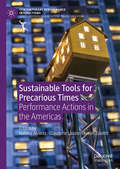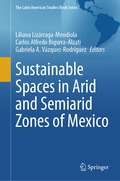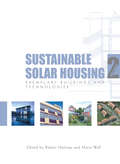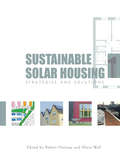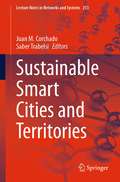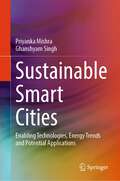- Table View
- List View
The Sustainable University: Progress and prospects (Routledge Studies in Sustainable Development)
by Stephen Sterling Larch Maxey Heather LunaThe direction of higher education is at a crossroads against a background of mounting sustainability-related issues and uncertainties. This book seeks to inspire positive change in higher education by exploring the rich notion of the sustainable university and illustrating pathways through which its potential can be realised. Based on the experience of leading higher education institutions in the UK, the book outlines progress in the realisation of the concept of the ‘sustainable university’ appropriate to the socioeconomic and ecological conditions facing society and graduates. Written by leading exponents of sustainability and sustainability education, this book brings together examples, insight, reflection and strategies from the experience of ten universities, widely recognised as leaders in developing sustainability in higher education. The book thus draws on a wealth of experience to provide reflective critical analysis of barriers, achievements, strategies and potential. It critically reviews the theory and practice involved in developing the sustainable university in a systemic and whole institutional manner, including the role of organisational learning.While remaining mindful of the challenges of the current climate, The Sustainable University maps out new directions and lines of research as well as offering practical advice for researchers, students and professionals in the fields of management, leadership, organisational change, strategy and curriculum development who wish to take this work further.
Sustainable Transportation Planning: Tools for Creating Vibrant, Healthy, and Resilient Communities (Wiley Series in Sustainable Design #16)
by Jeffrey Tumlin"The Great American Dream of cruising down the parkway, zipping from here to there at any time has given way to a true nightmare that is destroying the environment, costing billions and deeply impacting our personal well-being. Getting from A to B has never been more difficult, expensive or miserable. It doesn't have to be this way. Jeffrey Tumlin's book Sustainable Transportation Planning offers easy-to-understand, clearly explained tips and techniques that will allow us to quite literally take back our roads. Essential reading for anyone who wants to drive our transportation system out of the gridlock." -Marianne Cusato, home designer and author of Get Your House Right: Architectural Elements to Use and Avoid ?The book is full of useful ideas on nearly every page.? ? Bill DiBennedetto of Triple Pundit As transportations-related disciplines of urban planning, architecture, landscape architecture, urban economics, and social policy have undergone major internal reform efforts in recent decades Written in clear, easy-to-follow language, this book provides planning practitioners with the tools they need to achieve their cities? economic development, social equity and ecological sustainability goals. Starting with detailed advice for improving each mode of transportation, the book offers guidance on balancing the needs of each mode against each other, whether on a downtown street, or a small town neighborhood, or a regional network.
Sustainable Transportation Planning: Tools for Creating Vibrant, Healthy, and Resilient Communities (Wiley Series in Sustainable Design #16)
by Jeffrey Tumlin"The Great American Dream of cruising down the parkway, zipping from here to there at any time has given way to a true nightmare that is destroying the environment, costing billions and deeply impacting our personal well-being. Getting from A to B has never been more difficult, expensive or miserable. It doesn't have to be this way. Jeffrey Tumlin's book Sustainable Transportation Planning offers easy-to-understand, clearly explained tips and techniques that will allow us to quite literally take back our roads. Essential reading for anyone who wants to drive our transportation system out of the gridlock." -Marianne Cusato, home designer and author of Get Your House Right: Architectural Elements to Use and Avoid ?The book is full of useful ideas on nearly every page.? ? Bill DiBennedetto of Triple Pundit As transportations-related disciplines of urban planning, architecture, landscape architecture, urban economics, and social policy have undergone major internal reform efforts in recent decades Written in clear, easy-to-follow language, this book provides planning practitioners with the tools they need to achieve their cities? economic development, social equity and ecological sustainability goals. Starting with detailed advice for improving each mode of transportation, the book offers guidance on balancing the needs of each mode against each other, whether on a downtown street, or a small town neighborhood, or a regional network.
Sustainable Transportation: Indicators, Frameworks, and Performance Management (Springer Texts in Business and Economics)
by Henrik Gudmundsson Ralph P. Hall Greg Marsden Josias ZietsmanThis textbook provides an introduction to the concept of sustainability in the context of transportation planning, management, and decision-making. The book is divided into two parts. In the first part, indicators and frameworks for measuring sustainable development in the transportation sector are developed. In the second, the authors analyze actual planning and decision-making in transportation agencies in a variety of governance settings. This analysis of real-world case studies demonstrates the benefits and limitations of current approaches to sustainable development in transportation. The book concludes with a discussion on how to make sustainability count in transportation decision-making and practice.
Sustainable Transport for Chinese Cities (Transport and Sustainability #3)
by Roger L. Mackett Anthony D. May Masanobu Kii Haixiao Pan Stephen Ison Jon ShawThe volume is based on papers presented at a workshop on the green transport agenda and its implications for Chinese cities, organised by the World Conference on Transport Research Society in September 2010. The five sections of this volume review the challenges facing urban transport internationally and in China. It considers approaches to policy formulation, the challenge of urban mobility and the development of green sustainable transportation, by reviewing best practice in objective setting, strategy analysis and policy selection, and comparing these with current practice in China. The authors examine passenger transport, and considers a number of current policy interventions in China and compare these with western experience with demand management and new vehicle technologies. Topics include 5D land-use transport model for a high density, rapidly growing city and Contextual requirements for electric vehicles in developed and developing countries. Finally freight and logistics is addressed, including the role of freight villages and milk run strategies, and challenges and policy recommendations for road freight in Shanghai.
Sustainable Tools for Precarious Times: Performance Actions in the Americas (Contemporary Performance InterActions)
by Natalie Alvarez Claudette Lauzon Keren ZaiontzThis book charts the changing frontiers of activism in the Americas. Travelling Canada, the US, the US-Mexico border, Chile, Argentina, Brazil, Cuba, Colombia, and Indigenous territories on Turtle Island, it invites readers to identify networks, clusters, and continuities of art-activist tactics designed to exceed the event horizon of the performance protest. Essays feature Indigenous artists engaging in land-based activism and decolonial cyberactivism, grass-roots movements imagining possible futures through cross-sector alliance building, art-activists forwarding tactics of reinvention, and student groups in the throes of theatrical assembly. Artist pages, interspersed throughout the collection, serve as animated, first-person perspectives of those working on the front lines of interventionist art. Taken together, the contributions offer a vibrant picture of emergent tactics and strategies over the past decade that allow art-activists to sustain the energy and press of political resistance in the face of a whole host of rights emergencies across the Americas.
Sustainable Strategic Management
by Jean Garner Stead W Edward SteadSustainable strategic management (SSM) involves analysing, formulating, and implementing business strategies that are economically competitive, socially responsible, and in balance with the cycles of nature. SSM has emerged from the coevolutionary interactions of business organisations with the society they serve and the planet they call home. SSM strategic portfolios allow organisations to create competitive advantages by serving as agents of social change and ecological protection.This book has been specifically written as a text for traditional graduate and undergraduate strategic management courses, and its short length makes appropriate as a supplementary text in these courses as well. The authors have structured the book to follow the standard strategic management process, and they have included an ongoing descriptive case on Eastman Chemical Company designed to provide an in-depth example of the concepts presented in the chapters.From creating organisational visions and missions, to formulating, implementing, and evaluating goals and strategies, this book provides readers with new ways of thinking about their organisation's strategic role in the greater society and ecosystem now and in the future.
Sustainable Strategic Management
by Jean Garner Stead W Edward SteadSustainable strategic management (SSM) involves analysing, formulating, and implementing business strategies that are economically competitive, socially responsible, and in balance with the cycles of nature. SSM has emerged from the coevolutionary interactions of business organisations with the society they serve and the planet they call home. SSM strategic portfolios allow organisations to create competitive advantages by serving as agents of social change and ecological protection.This book has been specifically written as a text for traditional graduate and undergraduate strategic management courses, and its short length makes appropriate as a supplementary text in these courses as well. The authors have structured the book to follow the standard strategic management process, and they have included an ongoing descriptive case on Eastman Chemical Company designed to provide an in-depth example of the concepts presented in the chapters.From creating organisational visions and missions, to formulating, implementing, and evaluating goals and strategies, this book provides readers with new ways of thinking about their organisation's strategic role in the greater society and ecosystem now and in the future.
Sustainable Spaces in Arid and Semiarid Zones of Mexico (The Latin American Studies Book Series)
by Liliana Lizárraga-Mendiola Carlos Alfredo Bigurra-Alzati Gabriela A. Vázquez-RodríguezThis book portrays interesting aspects of communities where livability, comfort, materials, and traditional construction procedures are part of the cultural context. The book is focused on the importance of incorporating environmental criteria and sustainable infrastructure to contribute to the Sustainable Development Goals and to improve the population's quality of life in arid and semi-arid zones of the Global South. This book constitutes an introduction to the sustainable construction of livable spaces for undergraduate and postgraduate students, although professionals of the construction industry and urban policy makers will also find this work valuable.
Sustainable Solutions: Let Knowledge Serve the City
by B.D. Wortham-Galvin Jennifer H. Allen Jacob D.B. ShermanPortland, Oregon. Sustainability might not seem glamourous, but Portland is making a name for itself as one of the most sustainable cities in the world. Whether you’ve heard about the farmers’ markets, the cycle-friendly streets or the ongoing efforts to balance livability and equity, Portland is leading the way in urban sustainability: this book helps us understand how it achieves this.A critical component of Portland’s success is collaboration between different communities and institutions; the Sustainable Solutions series examines higher education’s role in these partnerships. In exploring how best to “let knowledge serve the city”, Portland State University translates its founding motto from mere words to applied research and action.This first volume examines different approaches to collaborative work that PSU has taken, both within the university and with community partners: how have barriers been overcome between different areas of study, between academia and the public, and why is bridging these divides so important? It also introduces the themes of the engaged university, social justice, climate change and sustainable economic development, which shape PSU’s work.Let Knowledge Serve the City is ideal for anyone seeking best practice in connecting students and universities with the needs of local communities. From public interest design and student leadership, to food justice and age-friendly development, authors combine academically rigorous theories of sustainability and community-university partnerships with lessons learned on how to realize ideals of sustainable development.
Sustainable Solutions: Let Knowledge Serve the City
by B. D. Wortham-Galvin Jennifer H. Allen Jacob ShermanPortland, Oregon. Sustainability might not seem glamourous, but Portland is making a name for itself as one of the most sustainable cities in the world. Whether you’ve heard about the farmers’ markets, the cycle-friendly streets or the ongoing efforts to balance livability and equity, Portland is leading the way in urban sustainability: this book helps us understand how it achieves this.A critical component of Portland’s success is collaboration between different communities and institutions; the Sustainable Solutions series examines higher education’s role in these partnerships. In exploring how best to “let knowledge serve the city”, Portland State University translates its founding motto from mere words to applied research and action.This first volume examines different approaches to collaborative work that PSU has taken, both within the university and with community partners: how have barriers been overcome between different areas of study, between academia and the public, and why is bridging these divides so important? It also introduces the themes of the engaged university, social justice, climate change and sustainable economic development, which shape PSU’s work.Let Knowledge Serve the City is ideal for anyone seeking best practice in connecting students and universities with the needs of local communities. From public interest design and student leadership, to food justice and age-friendly development, authors combine academically rigorous theories of sustainability and community-university partnerships with lessons learned on how to realize ideals of sustainable development.
Sustainable Solar Housing: Volume 2 - Exemplary Buildings and Technologies
by Robert S. Hastings Maria WallThis far-reaching and authoritative two-volume set examines a range of potential solutions for low-energy building design, considering different strategies (energy conservation and renewable energy) and technologies (relating to the building envelope, ventilation, heat delivery, heat production, heat storage, electricity and control). Energy and life-cycle impacts are considered as crucial factors, including passive and active solar use, daylighting and high efficiency conventional heat production. Each volume assesses the potential of these options in a variety of contexts, covering different housing types (apartment, row and detached) in cold, temperate and mild climates. The impressive list of expert authors from 14 countries includes a mix of internationally respected academics and practitioners, working together within the framework of a five-year International Energy Agency (IEA) research project. Volume 1 presents strategies and solutions, offering the reader a solid basis for developing concepts, considering environmental and economic concerns for housing projects in a variety of contexts. Volume 2 offers a detailed analysis of exemplary buildings in different European countries and examines the various technologies employed to achieve their remarkable performance. Aided by clear, full colour illustrations, it offers invaluable insights into the application of these technologies.
Sustainable Solar Housing: Volume 1 - Strategies and Solutions
by Robert S. Hastings Maria WallThis far-reaching and authoritative two-volume set examines a range of potential solutions for low-energy building design, considering different strategies (energy conservation and renewable energy) and technologies (relating to the building envelope, ventilation, heat delivery, heat production, heat storage, electricity and control). Energy and life-cycle impacts are considered as crucial factors, including passive and active solar use, daylighting and high efficiency conventional heat production. Each volume assesses the potential of these options in a variety of contexts, covering different housing types (apartment, row and detached) in cold, temperate and mild climates. The impressive list of expert authors from 14 countries includes a mix of internationally respected academics and practitioners, working together within the framework of a five-year International Energy Agency (IEA) research project. Volume 1 presents strategies and solutions, offering the reader a solid basis for developing concepts, considering environmental and economic concerns for housing projects in a variety of contexts. Volume 2 offers a detailed analysis of exemplary buildings in different European countries and examines the various technologies employed to achieve their remarkable performance. Aided by clear, full colour illustrations, it offers invaluable insights into the application of these technologies.
Sustainable Solar Housing: Volume 1 - Exemplary Buildings and Technologies
by Robert S. Hastings Maria WallThis far-reaching and authoritative two-volume set examines a range of potential solutions for low-energy building design, considering different strategies (energy conservation and renewable energy) and technologies (relating to the building envelope, ventilation, heat delivery, heat production, heat storage, electricity and control). Energy and life-cycle impacts are considered as crucial factors, including passive and active solar use, daylighting and high efficiency conventional heat production. Each volume assesses the potential of these options in a variety of contexts, covering different housing types (apartment, row and detached) in cold, temperate and mild climates. The impressive list of expert authors from 14 countries includes a mix of internationally respected academics and practitioners, working together within the framework of a five-year International Energy Agency (IEA) research project. Volume 1 presents strategies and solutions, offering the reader a solid basis for developing concepts, considering environmental and economic concerns for housing projects in a variety of contexts. Volume 2 offers a detailed analysis of exemplary buildings in different European countries and examines the various technologies employed to achieve their remarkable performance. Aided by clear, full colour illustrations, it offers invaluable insights into the application of these technologies.
Sustainable Solar Housing: Volume 2 - Exemplary Buildings and Technologies
by Robert Hastings Maria WallThis far-reaching and authoritative two-volume set examines a range of potential solutions for low-energy building design, considering different strategies (energy conservation and renewable energy) and technologies (relating to the building envelope, ventilation, heat delivery, heat production, heat storage, electricity and control). Energy and life-cycle impacts are considered as crucial factors, including passive and active solar use, daylighting and high efficiency conventional heat production. Each volume assesses the potential of these options in a variety of contexts, covering different housing types (apartment, row and detached) in cold, temperate and mild climates. The impressive list of expert authors from 14 countries includes a mix of internationally respected academics and practitioners, working together within the framework of a five-year International Energy Agency (IEA) research project. Volume 1 presents strategies and solutions, offering the reader a solid basis for developing concepts, considering environmental and economic concerns for housing projects in a variety of contexts. Volume 2 offers a detailed analysis of exemplary buildings in different European countries and examines the various technologies employed to achieve their remarkable performance. Aided by clear, full colour illustrations, it offers invaluable insights into the application of these technologies.
Sustainable Solar Housing: Volume 1 - Strategies and Solutions
by S. Robert Hastings Maria WallThis far-reaching and authoritative two-volume set examines a range of potential solutions for low-energy building design, considering different strategies (energy conservation and renewable energy) and technologies (relating to the building envelope, ventilation, heat delivery, heat production, heat storage, electricity and control). Energy and life-cycle impacts are considered as crucial factors, including passive and active solar use, daylighting and high efficiency conventional heat production. Each volume assesses the potential of these options in a variety of contexts, covering different housing types (apartment, row and detached) in cold, temperate and mild climates. The impressive list of expert authors from 14 countries includes a mix of internationally respected academics and practitioners, working together within the framework of a five-year International Energy Agency (IEA) research project. Volume 1 presents strategies and solutions, offering the reader a solid basis for developing concepts, considering environmental and economic concerns for housing projects in a variety of contexts. Volume 2 offers a detailed analysis of exemplary buildings in different European countries and examines the various technologies employed to achieve their remarkable performance. Aided by clear, full colour illustrations, it offers invaluable insights into the application of these technologies.
Sustainable Solar Housing: Volume 1 - Exemplary Buildings and Technologies
by S. Robert Hastings Maria WallThis far-reaching and authoritative two-volume set examines a range of potential solutions for low-energy building design, considering different strategies (energy conservation and renewable energy) and technologies (relating to the building envelope, ventilation, heat delivery, heat production, heat storage, electricity and control). Energy and life-cycle impacts are considered as crucial factors, including passive and active solar use, daylighting and high efficiency conventional heat production. Each volume assesses the potential of these options in a variety of contexts, covering different housing types (apartment, row and detached) in cold, temperate and mild climates. The impressive list of expert authors from 14 countries includes a mix of internationally respected academics and practitioners, working together within the framework of a five-year International Energy Agency (IEA) research project. Volume 1 presents strategies and solutions, offering the reader a solid basis for developing concepts, considering environmental and economic concerns for housing projects in a variety of contexts. Volume 2 offers a detailed analysis of exemplary buildings in different European countries and examines the various technologies employed to achieve their remarkable performance. Aided by clear, full colour illustrations, it offers invaluable insights into the application of these technologies.
Sustainable Smart Cities and Territories (Lecture Notes in Networks and Systems #253)
by Juan M. Corchado Saber TrabelsiThis book constitutes the proceedings of this year’s Sustainable Smart Cities and Territories International Conference (SSCt 2021), held in Doha, Qatar, from the 27th to the 29th of April 2021. The SSCt 2021 is an open symposium that brings together researchers and developers from academia and industry to present and discuss the latest scientific and technical advances in the fields of Smart Cities and Smart Territories. It promotes an environment for discussion on how techniques, methods, and tools help system designers accomplish the transition from the current cities towards those we need in a changing world. The program includes keynote abstracts, a main technical track, two workshops, and a doctoral consortium. The symposium is organized by the Texas A&M University at Qatar. We would like to thank all the contributing authors, the members of the Local Committee, Scientific Committee, Organizing Committee, and the sponsors (Texas A&M University of Qatar, AIR Institute and the IoT Digital Innovation Hub) for their hard work and dedication.
Sustainable Smart Cities: Enabling Technologies, Energy Trends and Potential Applications
by Priyanka Mishra Ghanshyam SinghThis book discusses the architecture, design and implementation of critical components of Sustainable Smart Cities to support governance, transportation, energy, healthcare, factories, technologies, securities, agriculture and education. The authors discuss the background of sustainable smart cities architectures and technologies and describe the problems that arise in design and implementation. In particular, this book discusses a proposed, 6G-based framework and architecture of IoT based sustainable smart cities. The authors describe the use of artificial intelligence in many zones of cities to increase the system's performance and efficiency. With the detailed discussion of energy management in smart cities, they have also presented how Internet of Vehicles (IoV) uses wireless communication and sensing technology to establish a network of information exchange between vehicles, infrastructure, and the environment. The discussion also includes Internet of Medical Things (IoMT) as well as Unmanned Aerial Vehicles (UAVs) for IoT based sustainable smart cities. This book explores societal, economic, and practical reforms that would promote smart cities, based on a variety of case studies.
SUSTAINABLE SECURITY C: Rethinking American National Security Strategy
by Jeremi Suri, Benjamin ValentinoAs the world shifts away from the unquestioned American hegemony that followed in the wake of the Cold War, the United States is likely to face new kinds of threats and sharper resource constraints than it has in the past. However, the country's alliances, military institutions, and national security strategy have changed little since the Cold War. American foreign and defense policies, therefore, should be assessed for their fitness for achieving sustainable national security amidst the dynamism of the international political economy, changing domestic politics, and even a changing climate. This book brings together sixteen leading scholars from across political science, history, and political economy to highlight a range of American security considerations that deserve a larger role in both scholarship and strategic decision-making. In these chapters, scholars of political economy and the American defense budget examine the economic engine that underlies U.S. military might and the ways the country deploys these vast (but finite) resources. Historians illuminate how past great powers coped with changing international orders through strategic and institutional innovations. And regional experts assess America's current long-term engagements, from NATO to the chaos of the Middle East to the web of alliances in Asia, deepening understandings that help guard against both costly commitments and short-sighted retrenchments. This interdisciplinary volume sets an agenda for future scholarship that links politics, economics, and history in pursuit of sustainable security for the United States - and greater peace and stability for Americans and non-Americans alike.
Sustainable Security: Rethinking American National Security Strategy
As the world shifts away from the unquestioned American hegemony that followed in the wake of the Cold War, the United States is likely to face new kinds of threats and sharper resource constraints than it has in the past. However, the country's alliances, military institutions, and national security strategy have changed little since the Cold War. American foreign and defense policies, therefore, should be assessed for their fitness for achieving sustainable national security amidst the dynamism of the international political economy, changing domestic politics, and even a changing climate. This book brings together sixteen leading scholars from across political science, history, and political economy to highlight a range of American security considerations that deserve a larger role in both scholarship and strategic decision-making. In these chapters, scholars of political economy and the American defense budget examine the economic engine that underlies U.S. military might and the ways the country deploys these vast (but finite) resources. Historians illuminate how past great powers coped with changing international orders through strategic and institutional innovations. And regional experts assess America's current long-term engagements, from NATO to the chaos of the Middle East to the web of alliances in Asia, deepening understandings that help guard against both costly commitments and short-sighted retrenchments. This interdisciplinary volume sets an agenda for future scholarship that links politics, economics, and history in pursuit of sustainable security for the United States - and greater peace and stability for Americans and non-Americans alike.
Sustainable Rural and Urban Ecosystems: Manual for Practice and Study
by Gunther Geller and Detlef GlücklichThese days human beings have a profound influence on aspects of the planetary ecosystem, e.g. on climate change and biodiversity, to name only two. This manual is intended to help practitioners, who are dealing with human-based rural and urban settlement-ecosystems, in the key steps towards their realization (design, implementation, and operation) and helpful for all, who are concerned about ensuring their practical sustainability. The ecosystem-approach is holistic and integrative, encompassing various disciplines like architecture, landscape architecture, environmental engineering, social sciences, life sciences, ecology, and management. It also considers issues such as energy-savings, ecological cycles, reuse, natural resources, socio-cultural background, real participation, and holistic quality management. Thus it not only explains the general concept, the steps of realization and the respective involved stakeholders, but also gives hints and tools for practitioners. The information, recommendations and tools are directed to the following target groups, among others: • Local planning authorities (giving hints for the procedure and the involved stakeholders) • Designers (holistic approach, procedures, tools) • Regulatory bodies, licensing and financing authorities (requirements for approach and procedures) • Construction and implementing firms and institutions (recommendations, tools) • Operating bodies (hints for operation, tools) The experiences are based on a joint German-Ghanaian program at Valley View University, the biggest private university in Ghana, intended to help realize the vision of a truly holistic ecological university. It was financed originally by the German Ministry of Education and Research and recently by the German Ministry for the Environment in the frame of the Climate Change Initiative of the Federal Government of Germany.
Sustainable Retail Development: New Success Strategies
by Jerry YudelsonSustainable Retail Development, addresses the emerging issue of green retail buildings and retail development that will grow significantly in importance over the next half-decade, a trend seen throughout the developed world. This volume is a practical and comprehensive guide to greening retail real estate, including green building and marketing strategies, corporate sustainability programs and features a 10-point “action program” for greening any retail real estate portfolio. Sustainable Retail Development, should be essential reading for professionals in design, construction and operations of shopping centers and retail stores. Well illustrated, this volume features over 30 green retail developments from North America, Europe, South America, Asia and Australia, as well as interviews with 25 leading industry experts.
Sustainable Resource Development In The Third World
by Doug Southgate John F DisingerOver time, scientists, technologists, and resource managers in affiuent countries have devised and institutionalized methodologies for exploiting and managing natural resources in their own environments with considerable success. In doing so, they have provided models, at least of development and affiuence, that the less developed countries seek to employ. An international symposium involving both invited and contributed papers addressing the technological and institutional challenges of sustainable development of natural resources in the Third World was staged in September 1985 in Columbus, Ohio, co-sponsored by The Argonne National Laboratory of Argonne, Illinois, The Tropical Renewable Resources Program and the School of Natural Resources of The Ohio State University, and the United States Agency for International Development. This volume presents selected papers from the symposium.
Sustainable Resource Development In The Third World
by Doug Southgate John F DisingerOver time, scientists, technologists, and resource managers in affiuent countries have devised and institutionalized methodologies for exploiting and managing natural resources in their own environments with considerable success. In doing so, they have provided models, at least of development and affiuence, that the less developed countries seek to employ. An international symposium involving both invited and contributed papers addressing the technological and institutional challenges of sustainable development of natural resources in the Third World was staged in September 1985 in Columbus, Ohio, co-sponsored by The Argonne National Laboratory of Argonne, Illinois, The Tropical Renewable Resources Program and the School of Natural Resources of The Ohio State University, and the United States Agency for International Development. This volume presents selected papers from the symposium.





